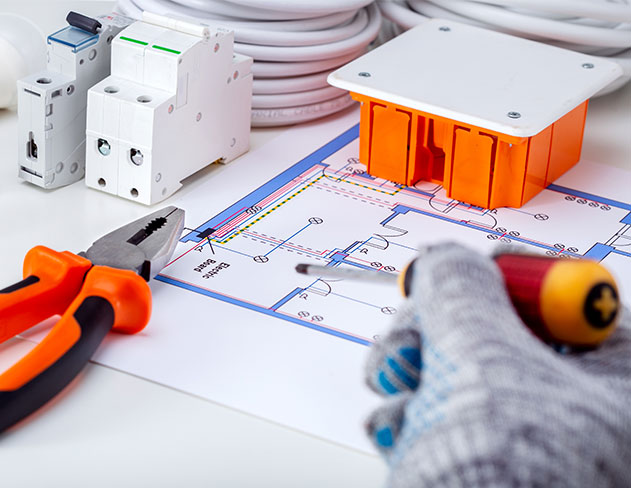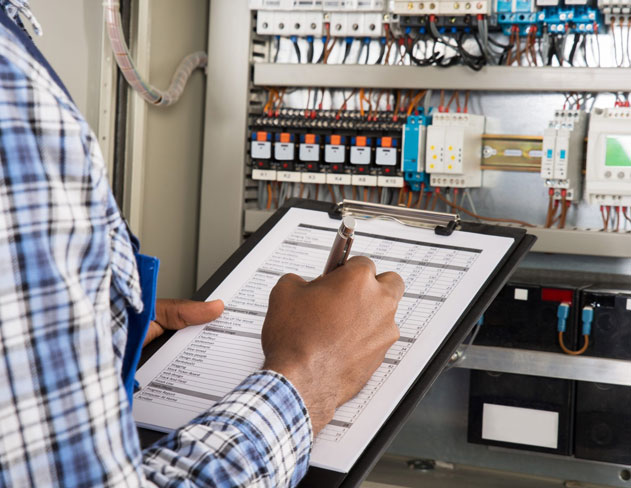Ensuring patient health and staff safety remains a priority for any healthcare facility. But when essential electrical equipment fails without warning, lives can be put at grave risk. This makes routine electrical checks imperative.
This guide explains what an Electrical Installation Condition Report entails so healthcare facility managers understand this crucial inspection process required to uphold safety.
Known as EICR for short, this comprehensive electrical survey serves a critical purpose – detecting defects or deterioration in wiring and appliances before small issues cascade into emergency failures. We’ll break down what areas electricians inspect, what hazards they look to identify, how they classify risks, and what fixes they may recommend.
Armed with complete clarity on the scope of EICR, managers can better ensure their building meets all wiring regulations and safety standards needed to enable quality care. Routine electrical tune-ups catch deficits before they disrupt vital operations and, most importantly, protect the vulnerable patients that rely upon smoothly functioning infrastructure in healthcare settings.
EICR Defined for Healthcare Facilities
An Electrical Installation Condition Report, or EICR, refers to a detailed inspection performed by a trained electrician to assess and document the current state of electrical systems in healthcare facilities.
The expert examines wiring, circuits, fixtures, appliances, and backup generators if present—checking for damage like frayed cords or overheated units as well as degraded parts, signalling future failure risk. The electrician also confirms installations meet national regulations.
Purpose and objectives of an EICR
The comprehensive inspection achieves a range of important objectives:
- It creates a log noting appliance functionality and wiring integrity, or lack thereof. Records detail what requires repair or replacement to sustain safety.
- Any identified hazards get neutralised before jeopardising care delivery. Something minor like a detached wire today could cause a complete system failure during critical moments later on if neglected over time.
- Electricians advise on suitable solutions, whether updating ageing panels or installing modern surge protectors to bolster protection.
- Facilities can certify all electrics adhere to the latest industry safety codes for healthcare spaces after addressing concerns raised.
- After addressing concerns raised, facilities can certify that all electrics adhere to the latest industry safety codes for healthcare spaces.
Ultimately, routine checks shore up electrical infrastructure vulnerabilities early on before minor issues balloon into dangerous and costly breakdowns.
In short, EICR offers electrical check-ups tailored to the unique needs of care-giving environments and the populations relying on properly functioning equipment.
National standards for electrical safety in healthcare properties
Industry regulations set guidelines to ensure safe electricity in healthcare buildings where individuals may rely more heavily upon properly functioning infrastructure should an emergency arise. Understanding key standards helps managers meet fundamental safety requirements.
Potential risks and hazards
During EICR inspection, electricians use coding like C1, C2 or F1 to classify discovered electric defects based on the urgency of recommended actions needed to control risks found.
C1 signals immediate danger from faults like damaged wiring until addressed. C2 represents issues that could turn hazardous if neglected over time. And F1 means monitoring for developing complications. Found risks range from fire and shock to burns or blunt injuries. So slight defects still warrant attention in healthcare settings serving vulnerable groups.
Need for regular inspections and maintenance
UK law mandates that landlords must commission an EICR every five years under the Electricity Safety Standards regulations to routinely detect lapses. Managers should check credentials to confirm an electrician possesses ample qualifications to assess facility electrics thoroughly, and perform each important safety review. The end report should also clarify the next steps to regain compliance.
Scope of EICR in Healthcare Properties
The scope of an EICR inspection is far-reaching to assess electrical integrity across healthcare facilities thoroughly. Additional precautions apply given these environments serve vulnerable individuals relying upon access to safely functioning equipment.
UK healthcare properties must meet stringent electrical safety regulations, including requirements of the Health and Safety at Work Act, among other codes. Specialist electricians understand these standards to evaluate compliance accurately. They also hold expanded certifications like Healthcare Facility Electrical Safety training on properly maintaining backup power generators. They know to check for unique classifications within report findings denoting issues stemming from ageing, sensitive medical appliances.
In essence, EICRs for healthcare assess all aspects of electrical distribution during scheduled maintenance. The main areas that are assessed during an EIRC in healthcare properties include:
- Condition of wiring and backups like transformers and generators
- Functionality of wall sockets, nurse call buttons, visitor WiFi routers
- Safety switches, alarm systems and appliance testing
- Exit sign visibility and wiring to life support devices
- Backup lighting functionality with battery depletion factored in
The comprehensive analysis determines if electrical infrastructure meets amplified healthcare facility safety codes for public areas, patient rooms and surgery floors alike. Electricians outline remediation requirements with patient populations in mind.
What Areas Fall Under EICR Review?
Electrical infrastructure checks apply to public access areas patients and visitors utilise, and behind-the-scenes medical areas. Reviewing a few key zones helps managers understand what specifically electricians inspect.
Patient Room Electrical Installations
Assessing electrical safety within patient rooms and wards falls centrally within EICR scope, given the prolonged occupancy by unwell individuals reliant on medical equipment. Electricians take special care to ensure the room’s wiring installations and appliances comply fully with healthcare regulations outlined in mandates like IEE Guidance Note 7. That standard provides instruction on electrical integrity across facilities housing recovering patients for extended stays.
EICR experts also account for specialised safety measures applied in patient quarters. These include anti-ligature designed powerpoints preventing harm and additional protective barriers guarding against fluid damage. Surge protectors back up life-preserving devices frequently transported between rooms. Electricians may test portable appliances through a formal PAT process to clear items for safe use near patients. Any deficiencies uncovered get noted and ranked based on the level of disruption posed to continual care.
Common areas such as corridors, waiting rooms, etc.
In addition to patient quarters, EICRs examine electrical infrastructure supporting common hospital areas utilised by visitors, patients travelling between appointments, and staff.
These public spaces span corridors providing main passageways, waiting rooms offering seating for appointments, breakrooms giving staff respite, and communal amenities regions. The waiting lounge, for example, may provide TV, WiFi, vending machines, sinks and workspaces. Size and layout vary based on room function. But electricians thoroughly check representative spaces by assessing:
Corridors Electrical Appliances + Fixtures
Electricians may document the number and position of wall-mounted corridor lamps wired to back up generators in case of emergencies. Cords stretched to floor cleaning devices also undergo safety checks.
Waiting Lounge Wiring
Every wired amenity, from Wi-Fi routers, TVs, and overhead speakers to wall sockets and dimmable lighting, undergoes examination in lounge areas. Backup support for charging stations is also assessed.
Accessibility Accommodations
Common areas are scrutinised to ensure electrical infrastructure complies with all accessibility regulations for safety and equitable access in public spaces.
Emergency lighting systems
Since healthcare facilities require reliable infrastructure to support potential crisis response, EICRs prioritise inspecting emergency lighting systems. Commonly used safeguards include power failure lighting, exit signs and egress lights.
Power failure fixtures triggered during an outage or disruption provide sufficient visibility for safe evacuation during incidents. Exit signs feature backup batteries to designate emergency egress routes should visibility fade clearly. Supplementary emergency lighting brightens pathway zones, guiding occupants outdoors.
Electricians thoroughly test backup activation, to ensure outage duration support estimates and sign/fixture visibility meet regulations. Key installation and maintenance standards followed include:
- NFPA 101 Code for Safety provisions ensuring illuminated emergency exit signs are stationed per room occupant load. Signs must hold enough battery capacity to operate for 90 minutes minimum.
- OSHA Standard 1910.37 mandates qualified personnel to formally inspect exit route lights and egress signs every 30 days. Issues get logged and addressed promptly.
- Adhering to NEC, IFC, NFPA, and OSHA guidelines ensures effective incident response support through electrical infrastructure resiliency measures.
Conclusion: What can Hexo Do For You?
At Hexo Electrical Testing, we specialise in commercial compliance services tailored to the unique infrastructure requirements of UK healthcare facilities. Our qualified electricians combine broad expertise with healthcare-specific training to support hospitals, clinics, care homes and more in upholding rigorous industry safety standards.
We provide the full spectrum of EICR services that healthcare environments rely upon:
Comprehensive Electrical Installation Checks
Our EICR certificates deliver the in-depth analysis of care settings, documenting appliance functionality while pinpointing risks and advising prompt resolution.
Emergency Lighting/Signage Inspections
We thoroughly test your backup lighting, exit route visibility and egress signage—ensuring effective support in crisis scenarios when infrastructure resilience matters most.
Portable Appliance Testing
Hexo electricians systematically check the safety of clinical equipment frequently transported on carts between hospital rooms using our onsite PAT testing capabilities.
In addition to testing and inspection, we also offer:
- Remedial Repairs
- Electrical Installation
- Infrared Scans Identifying Hotspots
As your comprehensive electrical compliance partner, Hexo helps healthcare facilities maintain hazard-free, operationally resilient infrastructure that fully supports quality care delivery. Get in touch today to learn more!
FAQs
What is the EICR in HMO?
An Electrical Installation Condition Report (EICR) is a detailed inspection that must legally be conducted, by a qualified electrician at least every five years in Houses of Multiple Occupancy (HMOs) to ensure the electrical infrastructure meets safety regulations for tenant-occupied dwellings.
Is it a legal requirement to have an EICR?
Yes, in the UK, it became a legal requirement for rented properties, including HMOs, to have an EICR inspection every five years under the Electrical Safety Standards regulations enacted in 2020. Non-compliant landlords risk facing fines or penalties.
Is EICR three years or five years?
The official interval between mandatory EICR inspections is once every five years for rented residences. However, some landlords elect to conduct checks more frequently such as once every 3 years, to identify potential electrical risks ahead of the formal deadline.
Can you let a property without an EICR?
Technically, homes can still be let without a valid in-date EICR, but this violates UK law. Local authorities may impose financial penalties if landlords cannot produce electrical safety documentation, putting tenants at potential risk. So, an EICR should always be completed first.

